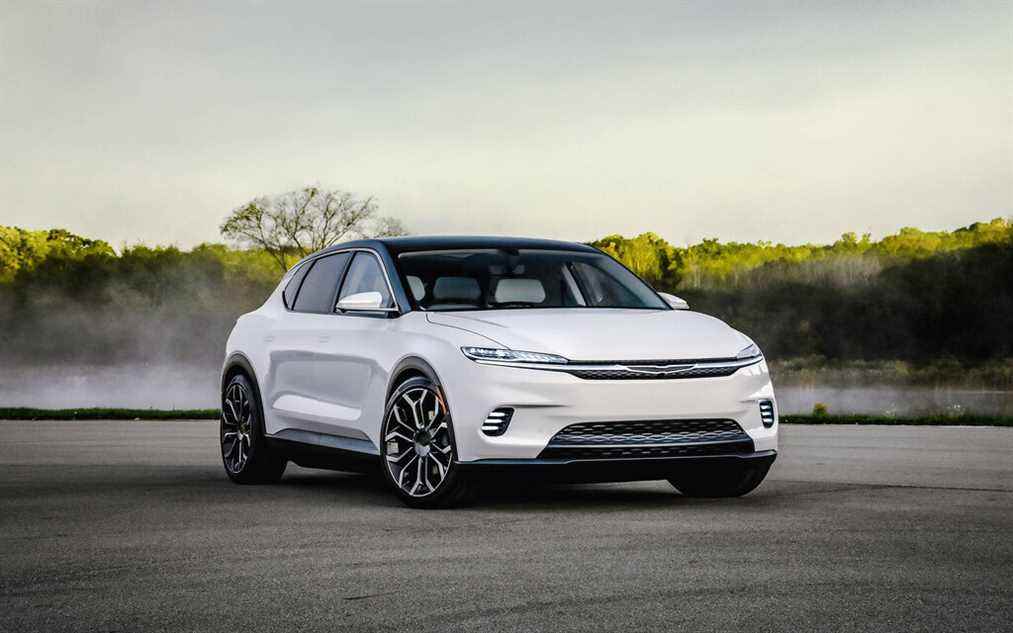Against all expectations, the manufacturer Stellantis stormed the Consumer Electronic Show (CES) to present much more than a new vehicle, but also part of its strategy for electrification of its range. A message that was long overdue from a manufacturer who in recent years, has increased its offers of V8 engines rather than really follow suit towards the electric.
From the outset, let’s first mention that this concept vehicle uses a name from the past, in this case that of the Chrysler Airflow. A car that was at the time avant-garde and more aerodynamic than its rivals.
In short, a name launched almost 80 years ago, but which fits perfectly with the DNA of this vehicle, obviously very close to a production model.
Photo: Chrysler
Taking the form of a mid-size crossover, the Chrysler Airflow is intended to be the automaker’s first all-electric vehicle (if you ignore the late Fiat 500e). A vehicle that should circulate on our roads in 2025 and which will be the first in a long line, since the Chrysler division intends to offer only 100% electric vehicles by 2028.
Using two respective 150kW electric motors housed on each axle, the Airflow offers an all-wheel drive system as well as an estimated range of between 350 and 400 miles (560 to 640 km). Battery size is not confirmed by Chrysler, although a graphic image showing a fully charged 118 kWh battery can be found in media materials. That said, the manufacturer is rather insisting on this new architecture called STLA Brain. A fully modular structure that can receive updates and can adapt to any type of vehicle.
It also incorporates a digital cockpit that can be configured according to the slightest wishes, as well as level 3 autonomous driving. On board, the Airflow offers an environment that is both modern and bright. Floating seats, glass roof and superb ambient lighting bring a breath of fresh air to this interior which is also distinguished by the presence of seven digital screens, including one for each of the occupants.

Photo: Chrysler
Aesthetically, the Airflow sports a slender dress which will probably constitute the future visual signature of the manufacturer. A line that is both sober and muscular which will certainly have the advantage of aging well, and which stands out for its long wheelbase and the presence of 22-inch rims. Also, by the presence of multiple LED lighting, surrounding the front and rear sections. Lighting which is sometimes animated and which changes to aqua blue when the vehicle is in charging mode.
Electric turn, relaunch of a brand
If the return of the name Airflow may seem brilliant given the vocation of the vehicle, we must also note by this unveiling the relaunch of the Chrysler division, literally on the brink of the abyss. A brand that has lost all form of identity, to which no one adheres, surviving only through a 300 sedan from another era and Grand Caravan / Pacifica vans. Vehicles ironically manufactured here and whose future is compromised (especially in the case of the 300), suggesting the possibility of a Canadian manufacture for some of the future products of the Chrysler division. Moreover, the Ontario factory in Windsor, which is currently assembling the Pacifica, would be considered for the manufacture of batteries for electric vehicles, rumors have been hovering for almost six months now.
The rebirth of the Chrysler division would therefore go through electrification. But should we also imagine that Chrysler will only play the luxury card? Most likely, since if the development of technologies goes first through this brand, the best way to make them profitable is to sell more expensive, with more luxurious vehicles. One can nevertheless imagine that several technologies developed by Stellantis for Chrysler will also find their place in Jeep, Ram and Dodge, another brand whose future remains nebulous for the moment.
In the meantime, here is a piece of news that marks a 180-degree turn for the Stellantis division, and which ultimately provides a brief overview of the strategy the manufacturer will adopt in the years to come.
